A significant cause of mortality of Richardson’s ground squirrels is predation. Male Richardson’s ground squirrels are probably more susceptible to predation than females, in part because adult males begin their active season earlier than adult females in spring and juvenile males end their active season later than juvenile females in autumn. Additionally, males are not as wary as females during the mating season, and males are more likely than females to undertake risky activities such as dispersing to unfamiliar areas. Major predators of Richardson’s ground squirrels include long-tailed weasels, badgers, hawks (buteos), and prairie falcons.
Long-tailed weasels (Mustela frenata)
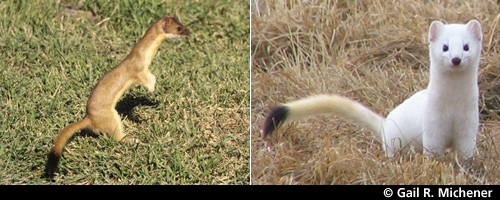
Long-tailed weasels raid nests of Richardson’s ground squirrels in search of infants, and weasel predation alone can reduce the juvenile population by 50% during a single season. Although long-tailed weasels weigh less than most adult Richardson’s ground squirrels, weasels can kill adult squirrels – especially by cornering them underground and inflicting a nape bite or throat bite. Adult ground squirrels often avoid being captured by weasels by remaining above ground and ground squirrels will even attack weasels when they are above ground.
American badgers (Taxidea taxus)

Although North American badgers occasionally ambush ground squirrels above ground, they specialize in digging ground squirrels out of their burrows. This method of hunting is especially effective in spring, when helpless infants are in the natal nest, and in autumn, when ground squirrels are torpid but the ground is not yet frozen. In some years, badgers capture 20-40% of litters in spring and 50-60% of hibernating ground squirrels. Because of their ability to use excavation to locate hibernating ground squirrels, badgers are the only predators that hunt ground squirrels both in summer and winter.
Other terrestrial predators
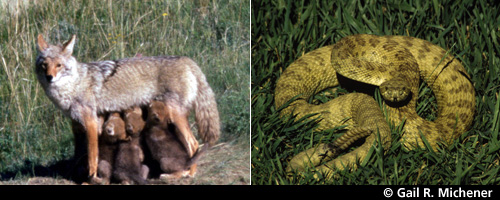
Terrestrial predators such as the red fox (Vulpes vulpes) and coyote (Canis latrans) [on left] feed on both adult and juvenile ground squirrels. In contrast, prairie rattlesnakes (Crotalus viridis) primarily capture juveniles. Domestic cats and dogs also hunt ground squirrels.
Hawks (buteos) and prairie falcons
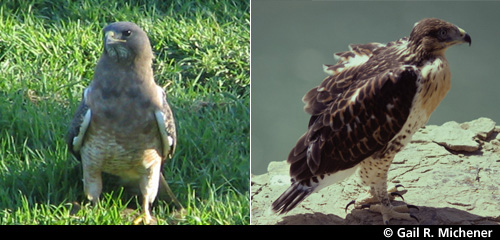
Richardson’s ground squirrels are usually the most important prey species fed to chicks by Swainson’s hawks (Buteo swainsoni) [on left], ferruginous hawks (Buteo regalis) [on right], red-tailed hawks (Buteo jamaicensis), and prairie falcons (Falco mexicanus). In Saskatchewan and Alberta, Richardson’s ground squirrels commonly account for 60-90% of prey items brought to chicks. When populations of ground squirrels decline, Swainson’s hawks switch to alternate prey such as ducklings, whereas ferruginous hawks experience reduced reproductive success.
Other aerial predators
Other aerial predators that occasionally eat Richardson’s ground squirrels include bald eagles (Haliaeetus leucocephalus), northern goshawks (Accipiter gentilis), and great horned owls (Bubo virginianus). Great horned owls are quite successful at capturing Richardson’s ground squirrels during the mating season, when males and estrous females remain active until sunset and thus overlap with the start of the owl’s hunting period.
Parasites
As with most animals, including humans, Richardson’s ground squirrels are hosts for a variety of parasites.
ECTOPARASITES
Flesh Flies
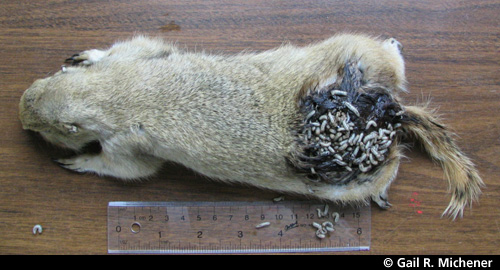
One of the most devastating parasites of the Richardson’s ground squirrels is the flesh fly Neobellieria citellivora (formerly known as Sarcophaga citellivora) whose maggots cause lethal myiasis. So far reported only in southern Alberta, the adult fly lays her live larvae on apparently healthy ground squirrels, usually somewhere on the animal’s back. The larvae, commonly referred to as maggots, then burrow beneath the skin and begin feeding on the ground squirrel’s tissues. Infested ground squirrels often carry burdens of over 200 larvae. Death of the ground squirrel is inevitable, usually within 5-6 days of infestation. N. citellivora flies are active from late June through September. Because adult Richardson’s ground squirrels immerge into hibernation in June and July and juvenile females immerge in August, parasitism by N. citellivora is more prevalent in juveniles than adults, and more prevalent in juvenile males than juvenile females. Although reported from only two populations of Richardson’s ground squirrels, both in southern Alberta, fly myiasis can account for the deaths of 10-15% of juvenile males.
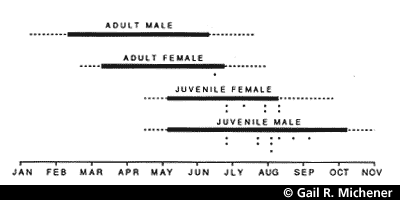
Overlap of the active seasons of the sarcophagid parasite Neobellieria citellivora and Richardson’s ground squirrels in southern Alberta. Solid bars indicate the period from the median date of emergence from hibernation to the median date of immergence into hibernation for each cohort of ground squirrels. Dotted lines indicate the period from earliest emergence to latest immergence. Solid circles below the bars show the number of squirrels within that cohort infested with maggots of N. citellivora. The active season of the fly starts about the time that most adult Richardson’s ground squirrels are already in hibernation.
Source: Michener (1993).
Fleas and Ticks
Ectoparasites such as fleas tend to have strong species-specific host preferences, so they rarely jump from ground squirrels onto humans or domestic pets. Some squirrels are heavily infested with fleas when they first emerge from hibernation or from the natal nest, but the number of fleas declines rapidly and many animals have none. Although two species of fleas (Opisocrostis labis and Oropsylla rupestris) and a species of tick (Dermacentor andersoni) are known vectors of sylvatic plague, there have been no confirmed reports of plague in Alberta for over 60 years. Of several thousand fleas collected in a 3-year study in Saskatchewan in the early 1950s, none carried the disease-producing organisms associated with sylvatic plague, tularemia, or Rocky Mountain spotted fever.
Endoparasites
Endoparasites include microscopic single-celled coccidians found in the digestive tract, as well as trypanosomes found in the bloodstream, lymph, and spinal fluid. Larger parasites include flatworms (cestodes and trematodes) and nematodes such as hookworms, pinworms and roundworms, as well as acanthocephalans or spiny-headed worms.
Even given this variety, the most common parasitic worm, the helminth Citellinema bifurcatus, has been found in less than one third of ground squirrels in Saskatchewan. Males and older squirrels are more commonly infested than females or juveniles.
Related Pages:
Survival & Longevity
Annual Activity Cycle
Sources: PDFs of many of these articles can be downloaded from the Michener Publications page
- Michener, G. R. 2004. Hunting techniques and tool use by North American badgers preying on Richardson’s ground squirrels. Journal of Mammalogy, 85: 1019-1027.
- Michener, G. R. 2001. Great horned owl, Bubo virginianus, predation on Richardson’s ground squirrels, Spermophilus richardsonii. Canadian Field-Naturalist, 115: 543-548.
- Michener, G. R. and A. N. Iwaniuk. 2001. Killing technique of North American badgers preying on Richardson’s ground squirrels. Canadian Journal of Zoology, 79: 2109-2113.
- Michener, G. R. 2000. Caching of Richardson’s ground squirrels by North American badgers. Journal of Mammalogy, 81: 1106-1117.
- Michener, G. R. 1993. Lethal myiasis of Richardson’s ground squirrels by the sarcophagid fly Neobellieria citellivora. Journal of Mammalogy, 74:148-155.
By other authors:
- Schmutz, J. K., C. S. Houston, and S. J. Barry. 2001. Prey and reproduction in a metapopulation decline among Swainson’s hawks, Buteo swainsoni. Canadian Field-Naturalist 115:257-273.
- Hunt, L. E. 1993. Diet and habitat use of nesting prairie falcons (Falco mexicanus) in an agricultural landscape in southern Alberta. M.Sc. thesis University of Alberta, Edmonton.
- Seville, R. S. & Stanton, N. L. 1993. Eimerian guilds (Apicomplexa: Eimeriidae) in Richardson’s (Spermophilus richardsonii) and Wyoming (S. elegans) ground squirrels. Journal of Parasitology, 79: 973-975.
- Galloway, T. D. 1990. Fleas (Siphonaptera) associated with ground squirrels (Spermophilus spp.) in Manitoba, Canada. Canadian Entomologist, 122: 449-458.
- Schmutz, J. K. & Hungle, D. J. 1989. Populations of ferruginous and Swainson’s hawks increase in synchrony with ground squirrels. Canadian Journal of Zoology, 67:2596-2601.
- Luttich, S., D. H. Rusch, E. C. Meslow, and L. B. Keith. 1970. Ecology of red-tailed hawk predation in Alberta. Ecology, 51:190-203.
- Burgess, G. D. 1955. Arthropod ectoparasites of Richardson’s ground squirrel. Journal of Parasitology, 41: 639-640.
